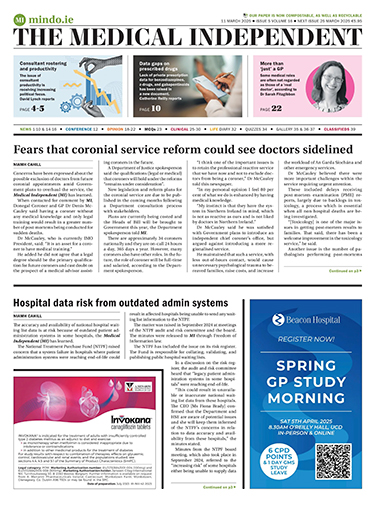‘Virtual wards’ are set to be operationalised at University Hospital Limerick and St Vincent’s University
Hospital in Dublin, initially for respiratory and cardiac conditions. Catherine Reilly reports
The establishment of a ‘virtual ward’ within a deadline set by Minister for Health Stephen Donnelly would be “a huge ask”, according to meeting minutes of the executive management team (EMT) at University of Limerick Hospital Group (ULHG) on 31 January 2024.
The minutes stated that no funding had been received for the initiative, which was announced by Minister Donnelly on 4 December 2023. “EMT will need to consider location of virtual ward. No funding received to date. Huge ask to have virtual ward operational in five months,” according to the minutes obtained under Freedom of Information law.
Fast forward to 14 June and the launch of the national virtual ward programme by the HSE. The virtual wards at University Hospital Limerick (UHL) and St Vincent’s University Hospital (SVUH) in Dublin are due to be operationalised this month – within the Minister’s deadline.
The ULHG meeting minutes from late 2023 and early 2024 reflected support for the virtual ward programme. But this was tempered by concerns around the timeline and staffing.
The involvement of ULHG was confirmed by CEO Prof Colette Cowan at an EMT meeting on 29 November, just days before the Minister’s announcement. On 24 January, the EMT heard of a ‘national call’ that was held to discuss the initiative and a “Ministerial directive” for implementation in quarter two of this year.
During the national call, ULHG Chief Clinical Director Prof Brian Lenehan raised concerns about the recruitment of 15 staff for this project.
“Request for email confirming permission to recruit and backfill positions. ULHG would not commit to implementation of same for Q2 2024 until confirmation of approval to recruit staff received.”
Prof Cowan requested a plan/report on the ULHG virtual ward for onward circulation to the executive council.
The matter was also on the EMT meeting agenda on 14 February, with minutes referencing “discussion around governance and location of same”.
‘Saved bed days’
The HSE national virtual wards programme involves several stakeholders, including eHealth Ireland, the National Clinical Programme in Respiratory, the National Heart Programme, SVUH and UHL.
A virtual ward is a “safe and efficient alternative” to HSE bedded care enabled by technology, according to the Department of Health. “Virtual wards support patients who would otherwise be in hospital to receive the acute care, monitoring and treatment they need in their own home.”
In the initial announcement in December, the Department said the initiative would potentially save over
8,000 bed days per year in each of the two hospitals.
“To assist in the delivery of the objectives of Sláintecare, to provide care closer to home and support patients to stay well in their own home for as long as possible, two pilots of the acute virtual ward programme were tested in Dublin and Letterkenny,” a Department spokesperson told the Medical Independent (MI) this month.
“Bed days saved by the establishment of the programme were estimated from the numbers of patients admitted to the virtual wards and the national average length of stay for these specific groups of patients and also from the experiences of the Norwich acute virtual wards in the UK, to which the newly established virtual ward programme will be closely aligned.”
The programme has received €1.5 million for additional staffing for the initial phase. “The staffing model builds on existing staffing resources to cover 24 hours a day and seven days a week service. Determination and finalisation of the staffing resource required for further expansion will be part of the evaluation of the programme,” said the Department spokesperson. The IT platforms are being funded from the digital health capital fund.
The aims of the programme include developing an agreed operating model (including clinical pathways) to be applied nationally; overseeing technology procurement and deployment; and developing and implementing an integrated national plan for roll-out to further sites in late 2024 and 2025 (following completion of a “robust evaluation”).
Prof Richard Greene, HSE Chief Clinical Information Officer, said: “In the initial stages, the service may be offered to suitable patients who are admitted to hospital with a respiratory or cardiac condition and are medically stable, but require ongoing monitoring and care.”
“Central to the national virtual wards programme is the empowerment of patients to be active partners in managing their health and wellbeing. Patients remain under the care of the consultant-led team that provided their care in the hospital and will have a dedicated team monitoring their care 24/7, while they are in the comfort of their own home.”
Presentation
According to a recent HSE presentation, the respiratory conditions included in the initial roll-out are: Acute exacerbation of chronic obstructive pulmonary disease (COPD); COPD with pneumonia; COPD with bronchiectasis; and bronchiectasis.
The cardiac conditions include heart failure; atrial fibrillation; and post-percutaneous coronary intervention.
The participating patients must be over 16 years of age and their consent is required for admission to the virtual ward.
Patients deemed fit by their consultant to complete their care in a virtual ward will be contacted by the virtual ward team. The team will meet with patients and their family or carer and explain how their care will be managed. The patients will have an opportunity to ask questions, according to the HSE.
The team will teach patients and their family/carer how to use the devices that monitor the patient’s health at home, and will agree the best ways to contact patients – this could be by telephone or video call.
They will also explain what to do if the patient feels unwell.
‘Collaborative’
Ms Loretto Grogan is the HSE National Clinical Information Officer for Nursing and Midwifery. She is Chair of the clinical pathways/standard operating procedures (SOPs) working group for the virtual ward programme.
Ms Grogan told MI all stakeholders have worked “collaboratively” towards the implementation deadline. The programme has developed “at pace”, but she did not consider the timeframe as overly tight. Ms Grogan emphasised that all aspects of the programme have been developed with the patient and their safety at its core.
She said during the Covid-19 pandemic, “we saw the benefits that virtual care could bring to patients, and to the workforce, and to the wider organisation.”
“Last year we developed a telehealth roadmap outlining some of the key building blocks and one of the first pieces of work we identified was the establishment of virtual wards,” she said. “The particular virtual wards we are establishing provide inpatient hospital level care at home, so the patients remain under the care of their consultant team – it is consultant-governed and nurse-led. It is a time-limited service and the patient then will be discharged as they would be if they were in a hospital bed.”
She said that “robust governance has been established”. A national clinical SOPs working group with broad multidisciplinary representation agreed the national pathways and templates. The national SOP templates were adapted for the relevant specialties by specialty-specific sub-groups led by the National Clinical Leads for Cardiology and Respiratory, Prof Ken McDonald and Dr Stanley Miller respectively. Local implementation groups were established to develop site-specific pathways.
Asked if the idea emerged within the HSE, or if the Minister asked for it to examined, Ms Grogan said “a lot of this has been coming from within the HSE”.
“Obviously, it is a Ministerial priority as well, and the Department have a focus on broadening out access to care. We work very closely with the Department on e-health – the Government has just launched its Digital for Care framework, and telehealth, virtual care, and the virtual wards, are very much called out in that.”
There is “real enthusiasm” among healthcare staff about the initiative. “It is new,” she acknowledged. “At the point of care in our Irish healthcare system we don’t have a huge amount of tech…unless you are in ICU or in one of the hospitals with an EPR [electronic patient record], of which we know there is only a handful.” The technology will be cloud-based with 24/7 technical backup for staff.
The capacity shortfall in acute hospitals, particularly at UHL, is well-documented. Ms Grogan said virtual wards will not solve such challenges, but they “will certainly work towards increasing access and giving options to patients”.
She said inpatient hospital stays can contribute to increasing frailty and deconditioning, for example. A patient in their own home will have greater scope to undertake activities of daily living, etc.
The programme also provides another option for the workforce. “Because we know there is a huge recruitment and retention problem, particularly in nursing.”
International models were examined during the development of a business case to support its launch. Fifteen whole-time equivalent (WTE) staff will be designated to each virtual ward, which will gradually scale up to 25 ‘beds’.
The 15 WTEs comprise of a clinical nurse manager (CNM) 3, other CNM grades, “experienced” staff nurses, and one administrator. As of 13 June a “significant proportion” of these roles had been filled and training has been taking place.
Ms Grogan confirmed a “a derogation was negotiated” and backfill arrangements were granted to the sites.
“We wanted experienced nurses coming into this programme because it is new. So any posts that have come from the hospitals, there was an agreement they will be backfilled… we won’t be taking from Peter to pay Paul.”
Under the current model, the virtual ward nurses will not go into the patient’s home. “The 15 WTEs, when you are looking at 24/7 care, is not a huge number, so they would not have the capacity to go into the patient’s home,” outlined Ms Grogan.
Virtual ward nurses will have direct contact with the patient before they leave the hospital ward. Patients’ first set of observations and readings will also be done in the hospital through the technology to ensure they are comfortable with the process. All of the virtual monitoring will take place at physical hubs established at both sites.
Asked if new consultant posts will be designated to such wards, Ms Grogan said the programme will be subject to a “really robust evaluation”.
“That evaluation is going to look at the workforce model, it’s going to look at staff experience, patient experience, and all the metrics, like bed days, patient cohorts going through, etc.”
She noted that some NHS sites had hired extra consultants for virtual wards depending on the model chosen.
A team from the School of Medicine at University College Dublin will conduct the evaluation, which is “built-in right from the start”.
“We have an evaluation cycle so we will be continuously feeding back to the steering committee in terms of patients, process, outcome measures etc. It will probably be six months before we have a really robust report to go into the system.”
Patients on the virtual wards will have “24-hour access” to virtual ward staff and will be monitored as if they were on an inpatient ward.
Ms Grogan said “very clear escalation pathways” have been defined.
Patients and carers have been engaged in the planning process. Some of the common queries have related to access to the ward staff and deterioration at home.
We wanted experienced nurses coming into this programme because it is new
Ms Grogan said patients in the virtual ward can return to the hub at any time for care; for example, if they need bloods or a chest x-ray.
In the event of a suspected respiratory or cardiac arrest, they/family member would need to call an ambulance in the usual manner through 999/112.
Where a patient feels unwell and needs to return to the hospital, there is an escalation protocol in place with the National Ambulance Service (NAS). Under protocol 37, the NAS can transfer the patient back to the hospital, rather than to the emergency department (ED).
Under the protocol, there will be direct access to a “designated area” in the hospital. The patient will not be brought to the ED unless it is a cardiac or respiratory arrest.
“That was a huge concern for patients, that if they did have to come back in, they would have to come back into [the ED], and they absolutely will not,” outlined Ms Grogan.
A recent HSE presentation indicated the potential involvement of community intervention teams (CITs). These teams provide enhanced services/acute intervention at home/in the community to meet patient needs and avoid hospital admission or support early discharge from acute care.
CITs will have a role in the administration of IV antibiotics in the programme, confirmed Ms Grogan.
The programme is working on how this will be operationalised with OPAT [outpatient parenteral antimicrobial service] and CIT colleagues. “With regards to the administration of other IV therapies this will depend on the particular therapy and decisions around this will be made through the appropriate clinical governance structures.”
Asked about a potential negative impact on CITs’ own programme of work, Ms Grogan said that “we are not going to let that happen” and communication will be ongoing.
Ms Grogan also confirmed a meeting has been held with GP representatives. She said GPs will be informed if their patient is admitted to a virtual ward and will be provided with clear information upon discharge.
“When we are providing care, the principles are going to stay the very same, it is just delivering it in a different way. That is a really important piece to highlight,” she added. “And that it is giving an option for patients. Hospitals are not easy places for patients to be. We have the technology now to do this safely.”
Commenting on the information released to date, Chair of the IMO consultant committee Prof Matthew Sadlier said a cohort of carefully selected patients could benefit from such an initiative, if it was sufficiently resourced.
However, he felt the number of suitable patients may be small. While supporting innovation, Prof Sadlier also said there were drawbacks to virtual versus in-person care, as well as the potential for technology failures. He also considered that a dedicated intervention team was required. He said an “external review” should be conducted “of potential cost productivity benefit”.
According to Prof Sadlier, new physical infrastructure was ultimately required to address the capacity deficit.
The IMO recently welcomed Minister Donnelly’s announcement of plans for 3,438 new hospital beds between now and 2031 as a “critical step” towards addressing a shortfall of 5,000 beds.













Leave a Reply
You must be logged in to post a comment.